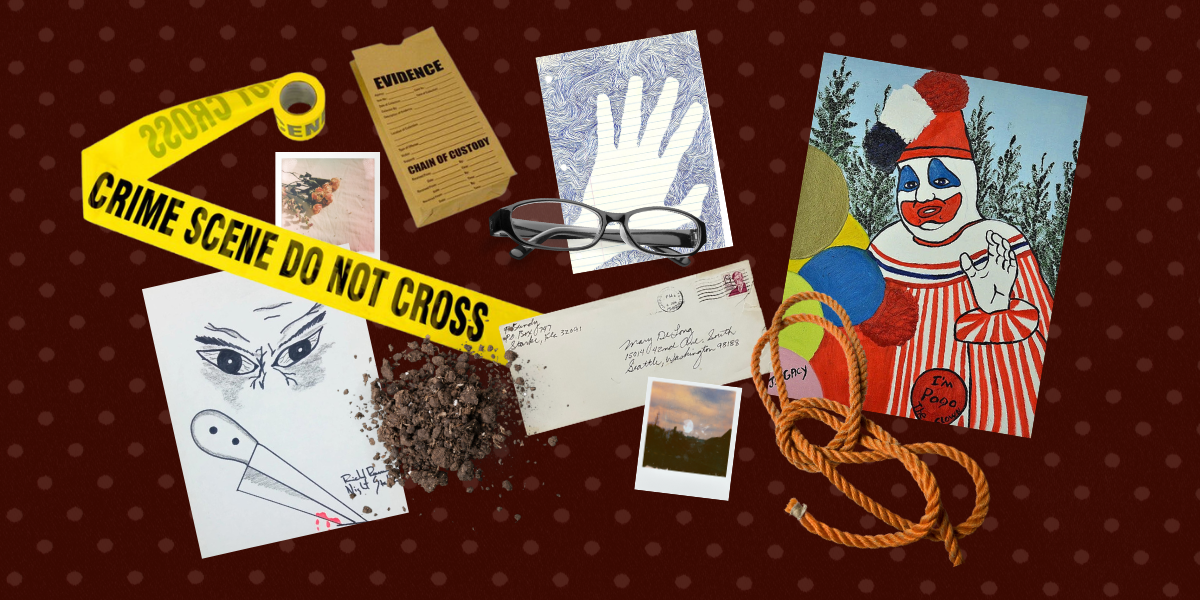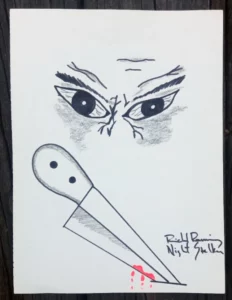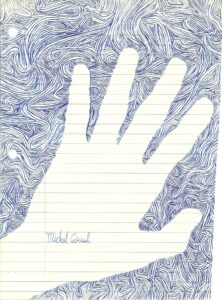Should items related to an infamous crime scene be advertised and sold just like furniture from a yard sale? Experts weigh in.

What is murderabilia?
Murderabilia, also known as murder memorabilia, refers to items that are associated with notorious crimes or murderers. These items can include anything from original newspaper clippings, offender clothing, weapons, and letters, to artwork created by the killers themselves.

A drawing done by Richard Ramirez, the Night Stalker, titled “Butcher Knife.” The piece sold for $1,200.
But, it doesn’t just stop there.
From our searches online, we’ve found other, more extreme sellers that advertise vials of dirt or containers of broken sticks from infamous crime scenes or grave sites for sale. Somehow, other sellers claim to have a hold of VHS tapes of crime scene walk-throughs, polaroid photo evidence — and even Charles Manson’s half-eaten bag of Reese’s Pieces.
The term murderabilia was coined more than 20 years ago by Andy Kahan, a crime victims advocate working for Crime Stoppers of Houston. Kahan is vehemently against this type of collecting, telling Huffington Post in 2012, “Murderabilia glorifies violent crime and causes the loved ones of victims undue pain.”
Despite the gruesome nature of these items, there is a significant market for them. Many people are willing to pay large sums of money to add them to their collections.
Why do people buy murderabilia?
There are seemingly endless reasons along the ethical and unethical spectrum for why someone would want to purchase items with a dark history.
For some, collecting these items may be a way to connect with the macabre side of human nature, to understand the darker aspects of society, or to explore the psychology behind these horrific crimes.
For others, it may simply be a fascination with true crime and a desire to own a piece of history.
William Harder, owner of Murderauction.com, shared with WTKR, “I often use the example of stamps. People who collect stamps aren’t in love with the post office. They’re not obsessed with mail. It’s just what they like to collect.”
How does someone get murderabilia?
Most of the items are obtained through the mail system, where inmates — whether the killer themselves or another person — ship items to another seller. That person then circulates the item through the market.
“For the most part, prison officials have no idea this is going on behind their back,” Kahan, the Crime Stoppers advocate, told a CBS affiliate.
He added that letters, hair, and art are the most common items.

Prison hand drawing done by Michael Carneal, who is currently serving life in prison after perpetrating the tragic 1997 school shooting at Heath High School.
Kahan added, “Right now, kind of the new thing is handprints where a serial killer will put their hand, and they’ll trace it, and they’ll put it out for sale.
As for the more extreme items like crime scene evidence, experts theorize some police officers smuggle evidence out for sale, while other items are simply fake. Crime scenes and gravesite dirt are collected by anyone.
Growing Controversy of the Industry
One of the most infamous murderers in history, Ted Bundy, has been the subject of plenty of murderabilia sales — and controversy.
In 2019, Zak Bagans, host of the widely popular Ghost Adventures, purchased the glasses Ted Bundy wore while abducting 12-year-old Kimberly Leach in 1978 for $50,000. Along with the glasses, Bagans bought the original brown evidence bag to complete the set, displaying the items in his Haunted Museum in Las Vegas.
Despite Bagans saying he’s keeping the glasses behind real jail bars where they’ll be locked forever “where they belong,” critics are quick to argue that his purchase is not altruistic by pointing out that the museum charges $48 for general admission.
Currently, the sale and profit off of murderabilia are legal in the United States.
Some argue that it is unethical to make money from the sale of items related to heinous crimes and that it trivializes the suffering of the victims and their families. Others are concerned that the sale of these items may encourage future offenders to commit similar crimes in an attempt to achieve notoriety.
Despite these fears, murderabilia continues to be popular and profitable.
‘Don’t like it, Don’t Buy it’
Maria DiLorenzo, a reporter based out of Brooklyn, New York, spoke with Robert Applewhite, the owner of Cult Collectibles, to discuss what he maintains is the largest cult and true crime murderabilia shop that ships worldwide.
“The big names are usually the most sought-after. Dahmer, Bundy, Gacy,” Applewhite explained.

John Wayne Gary profited off of oil paintings. This one depicts Pogo the Clown, 1985. It sold for $2.8 million in 2022.
When asked how he gets his items, Applewhite said he’d rather keep his trade secrets to himself but that he’s been in the business long enough to know where to go.
To that end, he argues that any anger regarding the ethics of his work should be directed elsewhere.
Applewhite says it’s the larger popular fascination with the true crime world that makes online stores like his “inevitable”
“There is a lot more money in true crime documentaries, books and magazines than there will ever be in murderabilia,” he told DiLorenzo. “I don’t see why someone would be fine with Netflix making money off a true crime case, but be mad that someone is selling a painting by that same criminal.
Harder of Murderauction.com has a similar take, telling CourtTV, “This is America. And there’s an old saying: Don’t like it, don’t buy it.”
Attempts to Stop the ‘Murderabilia Machine’
Kahan is still hard at work trying to stop the once-underground market from getting bigger. He’s an advocate for a stronger, federal version of the New York Son of Sam Laws.
These laws, named after the 1970s serial killer from New York, ban criminals from being able to profit from their stories through writings, film, or TV shows. They were created in 1977 after David Berkowitz sold his exclusive story rights to a publisher.
However, courts struck down the laws in 1987, siding with the publishing house’s argument that the restrictions infringe on someone’s First Amendment rights.
Kahan says he has worked to try and get a federal law passed to ban the sale of these items, but he has been unsuccessful.
Summing up his thoughts, Kahan recently told CourtTV, “There is absolutely nothing more nauseating and disgusting when you find out the person who murdered one of your loved ones now has items being hawked by third parties for pure profit.”
Love this post? Meet the Author.
Andrea Cipriano is the Digital Content Specialist at Uncovered, where she writes for the twice-weekly true crime newsletter, The Citizen Detective. Andrea graduated with a Master of Arts in Forensic Psychology from John Jay College of Criminal Justice where she focused on researching and peeling back the criminal mind. Andrea believes that it’s never too late for justice.
